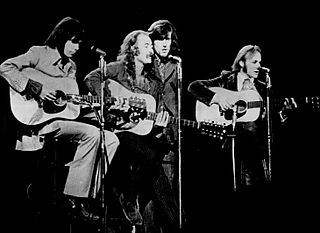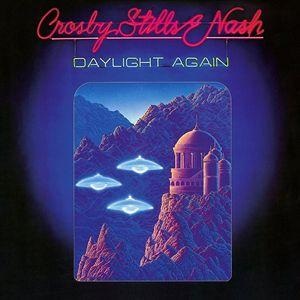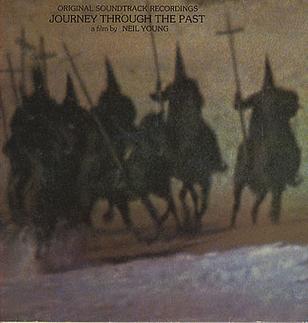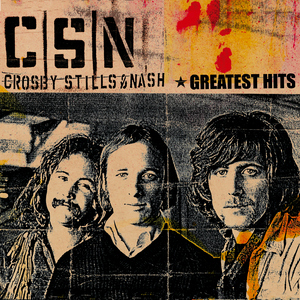
Crosby, Stills & Nash (CSN) was a folk-rock supergroup made up of the American singer-songwriters David Crosby and Stephen Stills and the English singer-songwriter Graham Nash. When joined by the Canadian singer-songwriter Neil Young, they were called Crosby, Stills, Nash & Young (CSNY). They are noted for their intricate vocal harmonies and lasting influence on American music and culture, their political activism and their tumultuous relationships.

Stephen Arthur Stills is an American musician, singer, and songwriter best known for his work with Buffalo Springfield, Crosby, Stills & Nash, and Manassas. As both a solo act and member of three successful bands, Stills has combined record sales of over 35 million albums. He was ranked number 28 in Rolling Stone's 2003 list of "The 100 Greatest Guitarists of All Time" and number 47 in the 2011 list. Stills became the first person to be inducted twice on the same night into the Rock and Roll Hall of Fame. According to Neil Young, "Stephen is a genius".

After the Gold Rush is the third studio album by the Canadian-American musician Neil Young, released in September 1970 on Reprise Records. It is one of four high-profile solo albums released by the members of folk rock group Crosby, Stills, Nash & Young in the wake of their chart-topping 1970 album Déjà Vu. Young's album consists mainly of country folk music along with several rock tracks, including "Southern Man". The material was inspired by the unproduced Dean Stockwell-Herb Bermann screenplay After the Gold Rush.

Déjà Vu, is the second studio album by American folk rock group Crosby, Stills & Nash, and their first as a quartet with Neil Young. Released in March 1970 by Atlantic Records, it topped the pop album chart for one week and generated three Top 40 singles: "Woodstock", "Teach Your Children", and "Our House". It was re-released in 1977 and an expanded edition was released in 2021 to mark its fiftieth anniversary.

Long May You Run is a studio album credited to the Stills–Young Band, a collaboration between Stephen Stills and Neil Young, released in 1976 on Reprise Records. It peaked at #26 on the Billboard 200 and was certified gold in the United States by the RIAA. The album is the sole studio release by Stills and Young as a duo.

CSN is the third studio album by Crosby, Stills & Nash, released on Atlantic Records on June 17, 1977. It is the group's second studio release in the trio configuration. It peaked at No. 2 on the Billboard Top Pop Albums chart; two singles taken from the album, Nash's "Just a Song Before I Go" and Stills' "Fair Game" charted on the Billboard Hot 100. It is currently the trio configuration's best selling record, outselling 1969's Crosby, Stills & Nash by 200,000 copies. It has been certified quadruple platinum by RIAA.

Daylight Again is the fourth studio album by Crosby, Stills & Nash, and their third studio album in the trio configuration. It peaked at No. 8 on the Billboard 200 albums chart, the final time the band made the top ten before the death of David Crosby in 2023. Three singles were released from the album, all making the Billboard Hot 100: "Wasted on the Way" peaked at No. 9, "Southern Cross" at No. 18, and "Too Much Love to Hide" at No. 69. The album was certified platinum by the RIAA with sales of 1,850,000.

"Marrakesh Express" is a song written by Graham Nash and performed by the band Crosby, Stills and Nash (CSN). It was first released in May 1969 on the self-titled album, Crosby, Stills and Nash, and released on a 45-RPM single in July of the same year, with another CSN song, "Helplessly Hoping", as its backing side. The single reached No. 28 on the Billboard Hot 100 on August 23, 1969. It reached the same position on the Easy Listening chart. The song was best received in the UK and Canada, reaching No. 17 in both nations. As a trio or quartet, this remains their only single to make the UK top 40 chart.

Journey Through the Past is a double LP soundtrack album from the film of the same name by Canadian / American musician Neil Young, released in November 1972 on Reprise Records, catalogue number 2XS 6480. It peaked at #45 on the Billboard 200. Its initial release was on vinyl, cassette tape, reel-to-reel tape, and 8-track tape cartridge. Although its follow-up Time Fades Away was finally released on CD in August 2017, Journey Through the Past remains the only 1970s Neil Young album yet to see an official CD reissue.

So Far is a 1974 compilation album by Crosby, Stills, Nash & Young. Shipping as a gold record and peaking at No. 1 on the Billboard Top Pop Albums chart, it was the band's third chart-topping album in a row. It has been certified six times platinum by the RIAA, and is the second best-selling album by any configuration of the quartet in tandem after their 1970 studio album, Déjà Vu.

If I Could Only Remember My Name is the debut solo album by American singer-songwriter David Crosby, released on February 22, 1971, by Atlantic Records. It was one of four high-profile albums released by each member of Crosby, Stills, Nash & Young in the wake of their chart-topping 1970 album Déjà Vu. Guests on the album include Jerry Garcia, Graham Nash, Neil Young, Joni Mitchell, and other prominent West Coast musicians of the era.

Manassas was an American rock supergroup formed by Stephen Stills in 1971. It was used primarily for Stills' music, the band releasing two studio albums before disbanding in October 1973. They released a 1972 self titled debut and a second album titled Down the Road in 1973.

Stephen Stills is the debut solo album by American musician Stephen Stills released on Atlantic Records in 1970. It is one of four high-profile albums released by each member of Crosby, Stills, Nash & Young in the wake of their 1970 chart-topping album Déjà Vu, along with After the Gold Rush, If I Could Only Remember My Name and Songs for Beginners. It was primarily recorded between CSNY tours in London and Los Angeles. It was released in the United States on November 16, 1970, and in the United Kingdom on November 27, 1970.

Replay is a compilation album by Crosby, Stills & Nash, appearing in 1980 on the Atlantic Records label. It contains no material with Neil Young, but does include CSN solo projects. It peaked at No. 122 on the Billboard 200, their first album not to chart in the top ten.

American Dream is the fifth studio album by Crosby, Stills & Nash, and their second with Neil Young. Released in 1988 on Atlantic Records, it peaked at No. 16 on the Billboard 200 and has been certified platinum by the Recording Industry Association of America. To date, it is their final album of original material to receive either a gold or platinum citation by the RIAA. It is the highest-selling album by Neil Young in the 1980s. The album is dedicated to Jan Crosby, Anne Stills, Susan Nash and Pegi Young.

Greatest Hits is a compilation album by Crosby, Stills & Nash, released by Rhino Records in 2005. It peaked at No. 24 on the Billboard 200, debuting at that position on April 2, 2005 with first week sales of 33,000 copies, and spending eight weeks on the chart. Its current sales sit at over 640,000. The album was dedicated to Cass Elliot with great thanks to Neil Young.

Down the Road is the second and last studio album by Stephen Stills' band Manassas. It was released in April 1973, and peaked at number 26 in the US charts, to mixed reviews. "Isn't It About Time", a protest song, was released as the lead single and reached number 56 on the charts.

Whistling Down the Wire is the third album by Crosby & Nash, released on ABC Records in 1976, the second of the duo's three-album deal with ABC Records. Cassette and 8-track tape versions of the album were distributed by Atlantic Records, to which Crosby, Stills, Nash & Young were signed. It peaked at No. 26 on the Billboard 200 album chart and was certified gold by the RIAA. Two singles were released from the album, "Out of the Darkness" and "Spotlight," of which only the first charted on the Billboard Hot 100, peaking at #89.

4 Way Street is a live album by Crosby, Stills & Nash, and their second album as Crosby, Stills, Nash & Young. It was originally released as Atlantic Records SD-2-902, shipping as a gold record and peaking at No. 1 on the Billboard 200. A document of their tour from the previous year, the live recordings presented were taken from shows at the Fillmore East on June 2 through June 7, 1970; The Forum on June 26 through June 28, 1970; and the Auditorium Theatre on July 5, 1970.
"Guinnevere" is a song written by David Crosby in 1968. The song appears on Crosby, Stills & Nash's critically acclaimed eponymous debut album. The song is notable for its serene yet pointed melody and its unique lyrics, which compare Queen Guinevere to the object of the singer's affection, referred to as "m'lady".



















